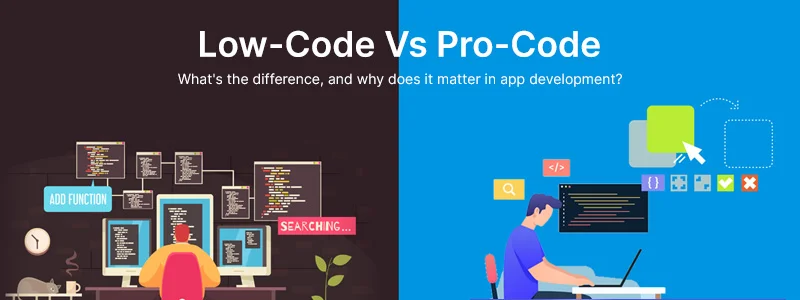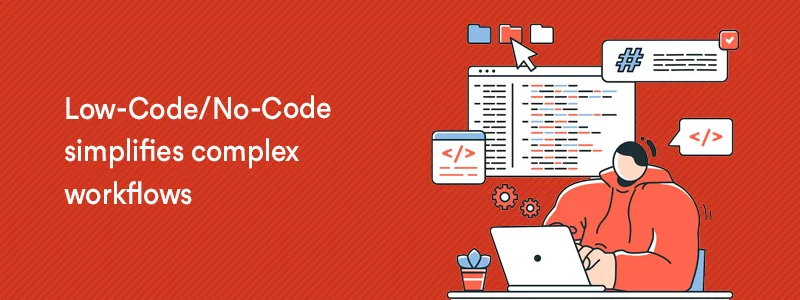
Evolution of Low Code Development Platforms
Modern Approach to App Development
Today’s low code platforms accelerate app development by streamlining the software development life cycle and play a vital role in any business that needs digital transformation. The low-code software development platform relieves developers of the stress of traditional coding implementation and lowers the cost of setup, training, and deployment. Both the developers and non-tech users can reap huge benefits from the low code.
The modern low code development platform is not only used to build the software easily but also used to debug, test and deploy the high secure application.
Below mentioned are the points the developers look for before entering into the low code platform:
- Before creating the app, ensure its functionality satisfies the business needs
- Understand the limits of app customization
- Check the migration of configurations from one environment to another
- Ensure security and reliability
- Check the overall quality and risk in maintainability
Pro Code Vs Low Code
Building the ideal app for your business may greatly impact how it operates and where it goes in the future. When it comes to developing an app, the first thing that comes to mind is whether to use low code or pro-code. To determine that, let’s now look at the pros and cons of low code and pro code.
Pro Code
High code and traditional code are two other terms used to describe Pro code. This entails sitting down and coding lines and lines of code, testing it, updating it, and so on until the project is complete. But it takes an enormous amount of time and money to deliver the application. The biggest disadvantage is that only qualified professionals can create sophisticated user interfaces for the app.
Merits
- Seamless integration with all systems
- Good knowledge of product structure
- Explore the code easily and fix bugs
- Create new synapses within the product
Demerits
- Only professional developers can create apps
- Takes a long time to build
- Slow setup and deployment
- Low productivity and high cost
Low Code
Low code is all about creating business apps using visual tools rather than hand-coding. Without the help of the IT department or technical developers, anyone can create an application. Unlike dealing with source code, a technical or non-technical developer can use the drag-and-drop technique to develop the applications.
Merits
- Increase the agility and speed of development
- No need to worry about syntax and programming commands
- Mostly depends on the libraries and algorithms
- It’s quite easy to develop software without coding knowledge
- Easy to accelerate changes and updates to the new product in a short time
- Allow non-tech users to build apps
Demerits
- Limited integration options
- Restrictions on modifying the source code
- There is no control over the performance of the software
- The app comprises enormous codes, so the code libraries need to handle many conditions and tasks.
- You never know whether the code will be compromised, which will result in business compliance and security risks
- Limited to common use cases
According to the research, 70% of web traffic comes from the use of smartphones and tablets. Many people prefer to use mobile applications because you can get anything from anywhere by using them. Businesses grab customer attention anytime by pushing the notification message. Higher conversation rates are done on mobile phones than on desktops. It allows the users to create mobile apps for android, iOS, and windows.
Before building an application, the technical or non-technical developer need to decide what type of app to develop:
- Web app: It can be accessed through web applications such as chrome, opera mini, or safari. One of the main advantages is that it works the same on all devices with different operating systems.
- Native app: It is designed for specific platforms and downloaded through app stores.
- Hybrid app: It can be built the same way as web applications, but it can be accessed through app stores.
React Native
In 2015, Facebook introduced the React Native open-source framework, which the developers use to build the mobile app efficiently. It uses the javascript programming language, which is the best cross-platform option for creating Android and iOS apps.
Benefits of using React Native
- Uses the native components of both operating systems to improve the performance of the app
- Uses the existing codes and pre-developed components
- Easily accessible to developers
- Supports live and hot reloading
- Reduces the app development cost by using the existing codes and implementing a smaller team
- Offers a simple user interface
- Uses modular architecture to modify and update the application easily
- Provides a large number of libraries to simplify the task
- Allows third-party plugins
Reactive Native has astounding features that are used to write the code once and run it on any operating system.
The technologies comprise in the path of best low code development platforms are:
- Visual Modeling: Visual representation is used to help developers understand the logic of application design easily.
- Drag and drop interface: This tool cut out the hard coding by dragging and dropping the modules to create an application.
- Declarative tools: It is used to remove the need of writing custom code. It helps to do future modifications and to speed up the development process.
- Security and scalability: The right low code platform has built-in security features that make data flow secure and scalable in the application.
- Workflow: The developers can easily create workflows to automate the business process.
Explore the sterlo low code android and iOS app development platform and gain access to all the tools you need to create the apps you desire.
Challenges in creating apps on low code platforms
Digital transformation plays a prominent role in the business process. The low code platforms help to meet the business needs, but it is impossible to satisfy the enhancement that comes in the future. It is also difficult to debug the apps developed in the low code platform. When it handles a large amount of data, it slows down the operational process of the application. Ultimately, if apps work slow, users lose productivity.
The developers need time to learn about the low code development tools and how to use them. Sometimes the low code development tools do not support the business needs. In such cases, developers need to write simple code to satisfy the business requirement. It is easy to write a simple code rather than using visual language to solve the business problem. At the same time, one cannot create an app on a different platform using a minimal code development process. Indeed, it is arduous to move the app to a different platform, and also there are limitations in integration.
With or without coding knowledge
With development platforms like sterlo, developers can build an app without coding knowledge. It is easy to develop an app using visual modeling and drag & drop features. The user with minimal coding knowledge can achieve the business needs by implementing simple codes. Without the support of the IT department, non-technical developers can break down the complexity of creating business apps. Modern businesses prefer to use the low code development platform because it aims to increase productivity in a short time and is also cost-efficient.
In the lockdown period, we are in the urge of receiving every product at the doorstep. Every company needs to be a technology company in some way to improve their business. At that point, the low code app development platform witnessed the demand for business growth and became a trend to follow.
sterlo Low-Code Platform
sterlo is a react-native mobile app development platform that allows tech and non-tech users to create apps that have a faster time to market. Initially, sterlo was used as an internal tool for developing Windows-based apps and a client version maintenance tool and had its BETA launch for Mobile Application in March 2020.
To build a strong force for change, our platform brings together people with ideas and those with the technical skills to put them into action. As the need for low-code platforms grows, sterlo emerges as a full-fledged low-code rapid application development platform for businesses. It is paving the way for businesses of all sizes to increase productivity and rethink how they run.
Get started with sterlo to hone your low-code app development skills!


